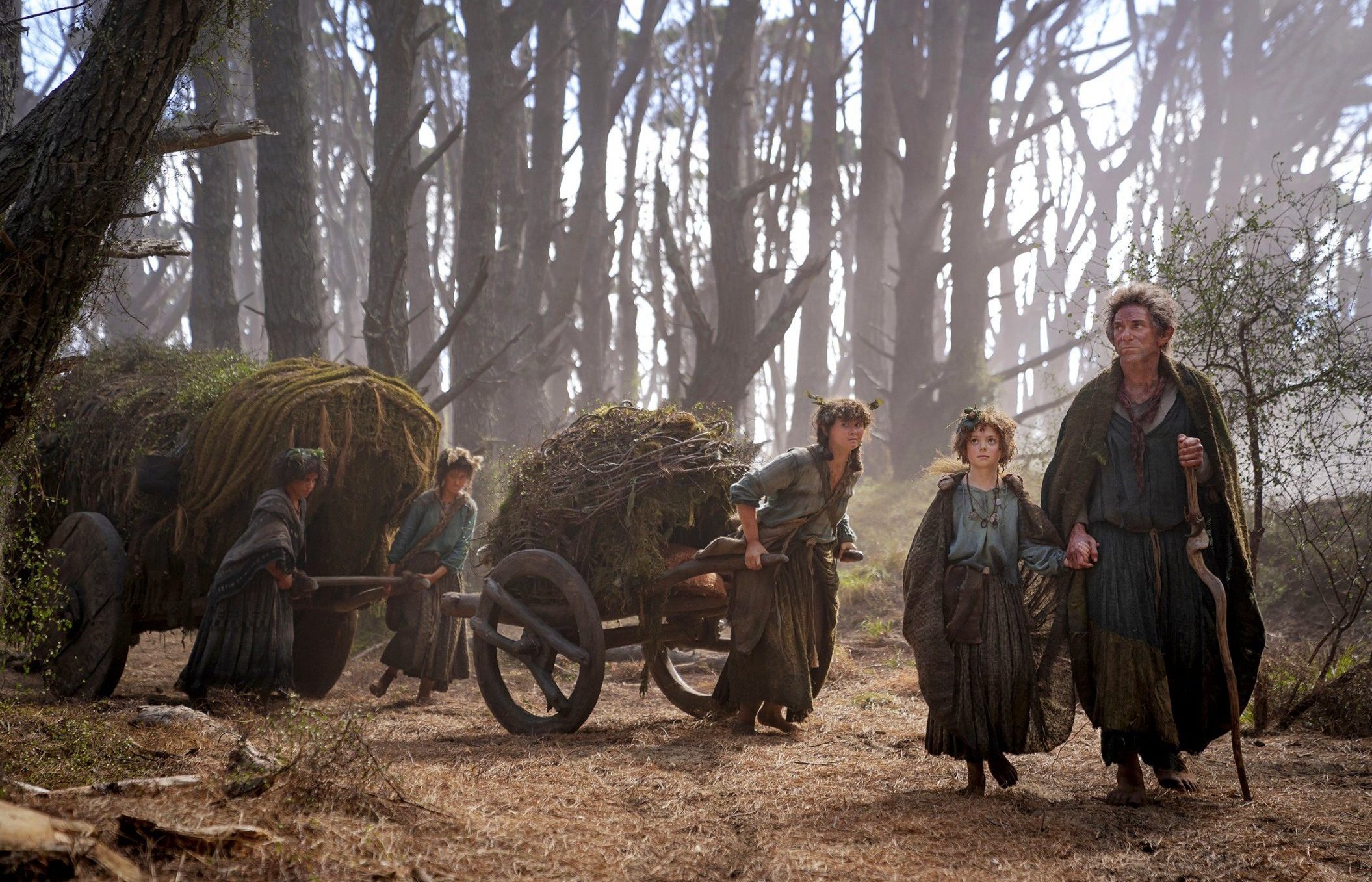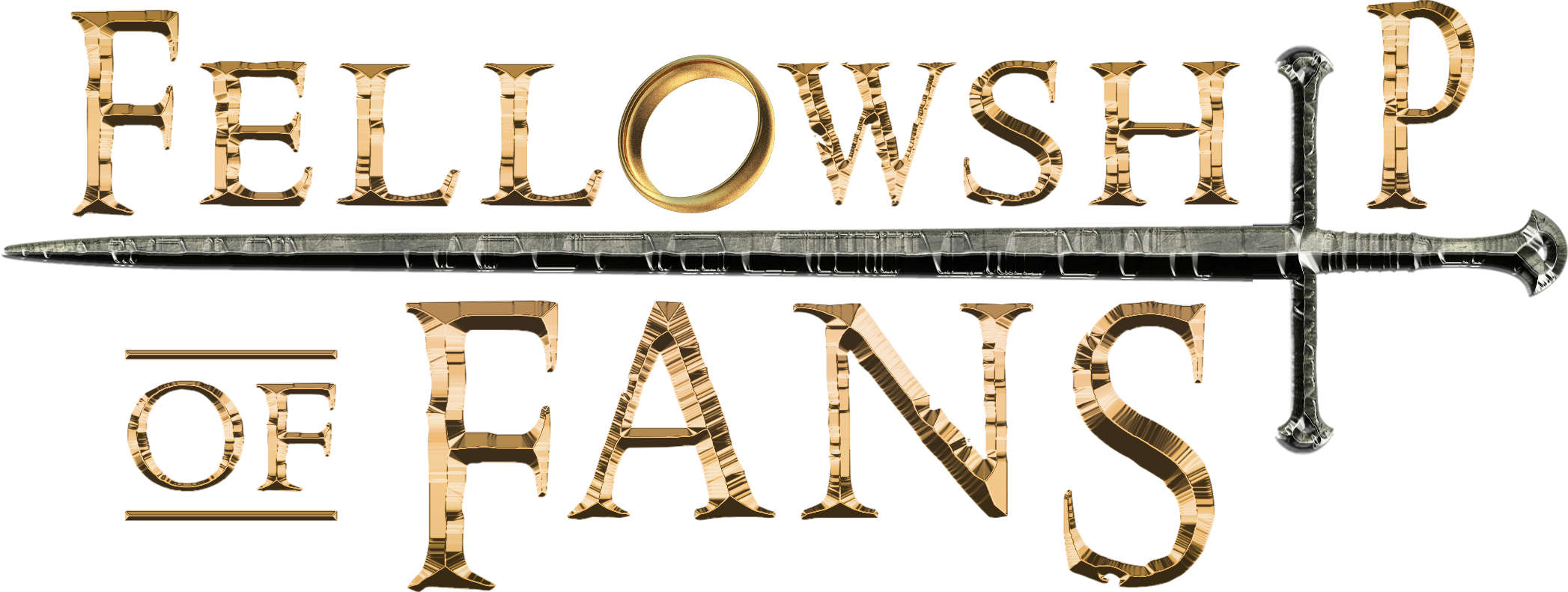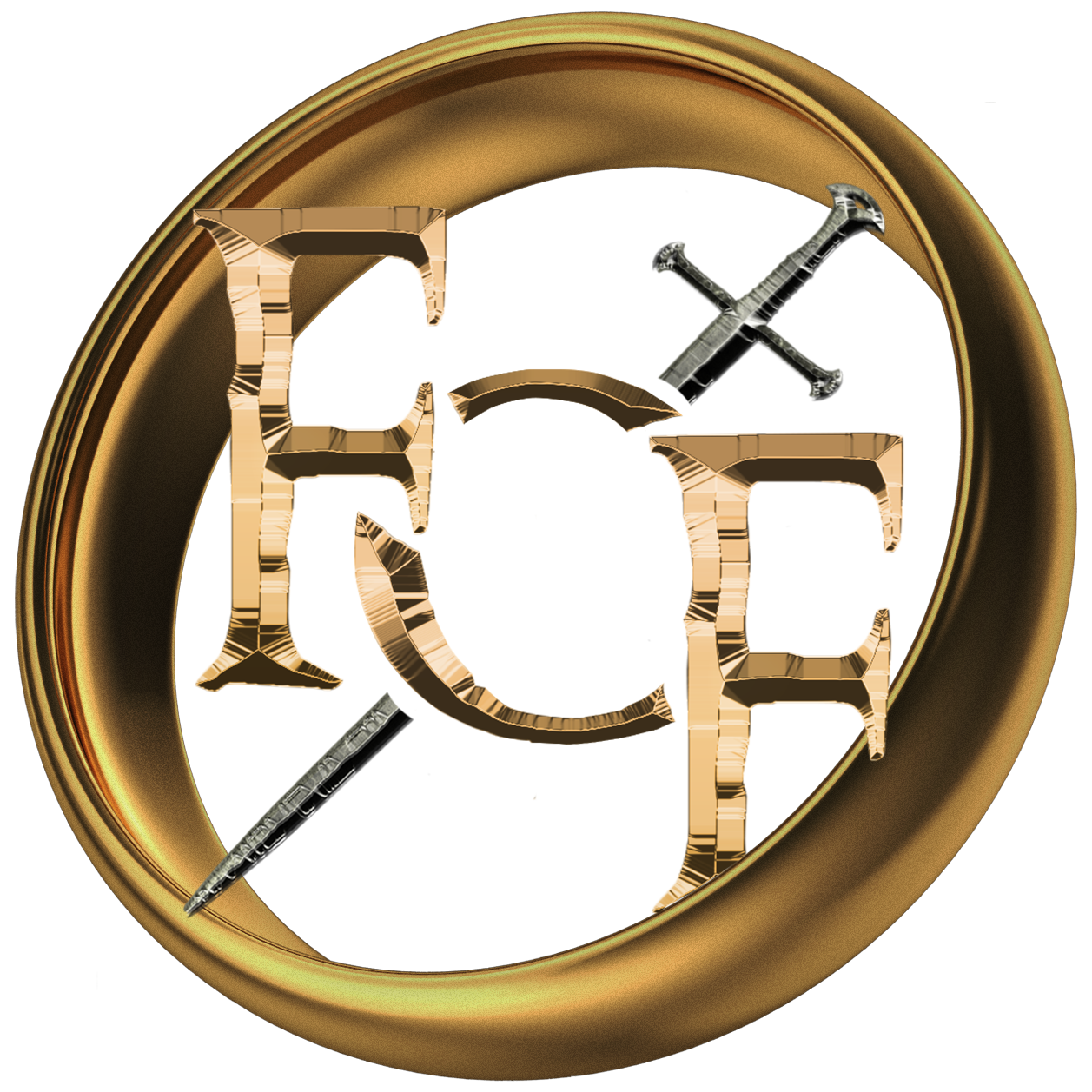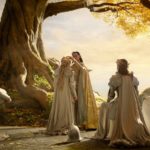
Concerning Harfoots
My dear Bagginses and Boffins, Tooks and Brandybucks, Grubbs, Chubbs, Hornblowers, Bolgers, Bracegirdles and Proudfoots.
—Bilbo Baggins
With less than three months to go until the release of Amazon’s The Rings of Power, the major news of the past few weeks is that Empire Magazine has published its July 2022 edition with a cover story on the show. The article includes new photographs from the show, as well as select quotes from the showrunners, several actors, and others involved in production. Also, last week the attendees of the London trip hosted by Amazon have had their embargo partially lifted. They are able to talk about their conversations with showrunners J.D. Payne and Patrick McKay, and with concept artist John Howe, but they are still prohibited from divulging the content of the 20 minutes of footage they viewed from the show. These moves appear to herald a new era in the (hitherto extremely secretive) marketing of the show. Among the new tidbits revealed by Empire, we get a closer look at the “Harfoots”, the Hobbit-like folk who will make an appearance in the show. We also get some new names. With the magazine cover reveals, Elanor (“Nori”) Brandyfoot (Markella Kavenagh) has been joined by her friend Poppy Proudfellow (Megan Richards), as well as Sadoc Burrows (Lenny Henry), who appears to be the leader of the show’s Harfoots. Further, within the article were revealed two more Harfoot names: Largo Brandyfoot (Dylan Smith) and Marigold Brandyfoot (Sara Zwangobani). This gives us a total of five Harfoot names so far.
Hobbits in the Second Age
The “Harfoots” are clearly nothing more than crypto-Hobbits. Their inclusion in the show has been somewhat controversial for several reasons, but the fact that they existed in the Second Age is not, or should not be. As the Prologue to The Lord of the Rings states:
The beginning of Hobbits lies far back in the Elder Days that are now lost and forgotten. Only the Elves still preserve any records of that vanished time, and their traditions are concerned almost entirely with their own history, in which Men appear seldom and Hobbits are not mentioned at all.
So clearly Hobbits have been around for a long time. Here the “Elder Days” most likely refers to the First Age, so they would have been around during the Second Age as well. However, as is made clear throughout The Lord of the Rings, the Hobbits are largely unknown to other people, and had hitherto (that is, before the end of the Third Age) done very little that was worthy of note, which is in part what makes Bilbo’s adventures and Frodo’s quest so notable. Gandalf tells Frodo the following regarding Sauron’s knowledge of Hobbits in “The Shadow of the Past” (The Fellowship of the Ring):
‘To tell you the truth,’ replied Gandalf, ‘I believe hitherto — hitherto, mark you — he has entirely overlooked the existence of hobbits. …’
This suggests (at least, if Gandalf’s belief is correct) that Sauron was unaware of the existence of Hobbits until the end of the Third Age, when he learned that his Ring had fallen into the possession of such a creature. Presumably this would mean that Sauron did not have any dealings with Hobbits in the Second Age, and they did not do anything significant that would have been reported to him by his servants.
Another concern some people have regarding the inclusion of Hobbits is the effect it will have on the tone of the show. Those who are already familiar with Tolkien’s Legendarium as represented by such works as The Silmarillion and Unfinished Tales of Númenor and Middle-earth (both posthumously published by J.R.R. Tolkien’s son Christopher) are aware that they possess a tone—keen, beautiful, serious, and often tragic—that is far removed from that of such works as The Hobbit. Tolkien himself noted this several times in his correspondence to people curious about his other works that were as yet unpublished. For example:
Also many of the older legends are purely ‘mythological’, and nearly all are grim and tragic: a long account of the disasters that destroyed the beauty of the Ancient World, from the darkening of Valinor to the Downfall of Númenor and the flight of Elendil. And there are no hobbits. (Letter 247 to Colonel Worskett, The Letters of J.R.R. Tolkien)
Of course, that last sentence does not mean that Hobbits were not around, but only that unlike Elrond, Galadriel, Celeborn, and so on, Tolkien did not see fit to include Hobbits in his stories of the First and Second Ages.
Although I was myself not in favor of the inclusion of Hobbits in the show for the above reasons, I did come up with a way I thought they could be included without going too much against Tolkien’s writings on the subject. I imagined them as coming from a region in the East, such as the land called Dorwinion in the Third Age. The actions of Sauron and his servants lead to war, which eventually effects the Hobbits, causing them to migrate to escape the destruction of war. They head westward, eventually ending in some part of Rhovanion, perhaps even the Vales of Anduin where they are first recorded as living in the Third Age. Interestingly enough, from the information available so far, this idea seems to be not far off the mark.
Harfoots
The crypto-Hobbits in The Rings of Power appear to be called “Harfoots”. I probably would have called them “Halflings”, or simply “Hobbits”. They have also been called “proto-Hobbits”, but they appear to be so much like Hobbits in all respects other than material culture (and perhaps behavior) that I’m not sure the “proto-” prefix is warranted. The word “Harfoot” is not something invented by Amazon’s creative team. It does come from Tolkien, but seems to have a rather different meaning in the show. In Tolkien the Harfoots are one of three major divisions of Hobbits (Harfoots, Stoors, and Fallohides) during the time when they lived in the Vales of Anduin, and after they migrated into Eriador during the middle of the Third Age:
The Harfoots were browner of skin, smaller, and shorter, and they were beardless and bootless; their hands and feet were neat and nimble; and they preferred highlands and hillsides.
This description is from the Prologue of The Lord of the Rings, as is this:
The Harfoots had much to do with Dwarves in ancient times, and long lived in the foothills of the mountains. They moved westward early, and roamed over Eriador as far as Weathertop while the others where still in Wilderland. They were the most normal and representative variety of Hobbit, and far the most numerous. They were the most inclined to settle in one place, and longest preserved their ancestral habit of living in tunnels and holes.
According to “The Tale of Years” in Appendix B of The Lord of the Rings, Hobbits (“The Periannath”) are first mentioned in records in the year 1050 of the Third Age, with the coming of the Harfoots to Eriador. In other words “Harfoots” are first heard of a millennium after the end of the Second Age. How long these three divisions of Hobbits existed is unknown, but they became much intermingled after settling in the Shire.
The name “Harfoot” apparently means “hair foot” (Old English hǣr + fōt), and refers to the hair on top of their feet. Observing the prosthetic feet of the show’s Harfoots, however, I wonder if they shouldn’t be known as “Callowfoots” instead. (The word “callow” is from Old English calu, meaning “bald”, “bare”, or “unfledged”, from which it gained its modern meaning of young and untested.) No doubt a few puffs of Old Toby would put some more hair on their feet, but that’s still some two and a half millennia in the future, at least.
Harfoot Names
Since Tolkien first published The Hobbit, Hobbits have been known for their English-like names. Even if some of their given names may seem rather nonsensical, their surnames all sound very English indeed. However, English surnames have only been around for between half a millennium to a millennium, and Tolkien seems to indicate a similar history for Hobbit names. The brothers Marcho and Blanco, who founded the Shire in T.A. 1601, are known only by their given names. Likewise Bucca, the first Thain of the Shire in T.A. 1979, unless one takes “of the Marish” to be his surname. Even as late as T.A. 2460-70, Sméagol and Déagol are only known by their given names. Given this, it seems odd to me that the “Harfoots” of the Second Age would have names very similar to those of the Hobbits of the Shire in the late Third Age. That would be like coming across a typical modern English name in a record of the Trojan War, or of the reign of King Solomon.
These Harfoot names do all sound rather Hobbit-like at first blush, which no doubt was the intended effect, but whether they will hold up to scrutiny is a debatable point. Some of these names have been criticized for looking like they came from a random Hobbit name generator, and when Elanor Brandyfoot’s name was first revealed, I decided to invent my own “Harfoot” name: Odo Proudbottle. Is this a valid criticism, though? So far we have a sample size of five names total for The Rings of Power’s Harfoots, out of a cast of seven known actors portraying them: Markella Kavenagh, Megan Richards, Lenny Henry, Thusitha Jayasundera, Sara Zwangobani, Dylan Smith, and Beau Cassidy. (Thusitha Jayasundera apparently plays Sadoc Burrows’ wife, and Beau Cassidy seems to be playing Largo Brandyfoot’s daughter, and likely Elanor’s younger sister.) The character names of the latter two have not yet been released. Here I will discuss the five names revealed so far.
Elanor “Nori” Brandyfoot: There has been some criticism of her nickname “Nori”, which is identical to that of a male Dwarf in The Hobbit. I am not bothered by it. It is a coincidence of the sort that often exists in real languages. Some have also criticized her given name because it is the name of a flower that grows in Lothlórien, a place where Hobbits are unlikely to have ever set foot before Frodo’s quest. The flower’s name, elanor, is from Sindarin, and means “sun-star”. It’s possible that the name could refer to more than one type of flower, as is often the case with the names of plants and animals in real life. Even if it is the same flower though, I don’t see that it is unreasonable to suppose that the flower may grow elsewhere, even if it doesn’t seem to be common in the Shire. However, the fact that the name is Sindarin is perhaps another issue, as it seems unlikely these Harfoots would be familiar with the language. Nevertheless, it is the only name by which we know the flower, thus the necessity of using the Sindarin word for purposes of translation. Finally there is the surname “Brandyfoot”, which I do not care for at all. It appears to be a portmanteau of the Shire surnames “Brandybuck” and “Proudfoot”. What it could mean is not apparent, though. The Brandybucks took their name from the Brandywine River, which presumably is not where the Harfoots are from in The Rings of Power. Perhaps it refers to the alcoholic drink, but that seems to make no sense, unless perhaps it refers to the stumbling one does when drunk. The Brandywine apparently means “golden-brown river” in Sindarin, with a punning name meaning “border river” in Westron. So perhaps “Brandyfoot” could mean something like “brown foot” or “border foot”, although for the latter I would just stick to English and use “Marchfoot”.
Poppy Proudfellow: I see nothing wrong with this name, apart from the modernness of its form. Like “Elanor”, “Poppy” appears to be a flower name. The flower is common in many parts of the world, including Europe and Asia, and in fact there is one Poppy Chubb-Baggins who is related to Bilbo Baggins. The name “Proudfellow” also works fine. If a foot can be proud, certainly a fellow can be proud as well. Also, the name alliterates, just as “Bilbo Baggins” does. And many of J.K. Rowlings’ characters…
Sadoc Burrows: This surname is probably the least objectionable, because Hobbits dig holes after all. Bilbo had a distant cousin, Peony Baggins, who was married to one Milo Burrows. Also, his belongings were being auctioned off by Messrs Grubb, Grubb and Burrowes at the end of The Hobbit. Some people have expressed a distaste for the name Sadoc. It is, in fact, also a Tolkienian name, belonging to one Sadoc Brandybuck. The intended meaning or origin of the name is not clear. Many of the Brandybucks have medieval Welsh names, and “Sadoc” is a name that appears in Arthurian legends. However, before I knew the name was from Tolkien, I thought that it might derive from the Hebrew name Zadok, meaning “righteous”. Perhaps that meaning is also intended.
Largo Brandyfoot: I’ve already covered the Brandyfoot surname. Largo is a Romance word (that is, derived from Latin) typically meaning “large” or “long”. It is also the name of Largo Baggins, the great-grandfather of Frodo Baggins.
Marigold Brandyfoot: Marigold is yet another flower name. In the Old World marigolds are native to the Mediterranean and Africa. Marigold Gamgee is the name of a sister of Samwise Gamgee.
The Verdict
Presumably there will be more Harfoots and Harfoot names in the show, but these seem to be the main characters, and so these names are likely the ones we will be most familiar with. So far the biggest issue I have is with the name “Brandyfoot”. If it is not nonsensical, it is at least not clearly sensical, so to speak. Perhaps we will learn more about its meaning and significance in the show, but I’m not counting on it. As for Harfoot names in general, I am still not fond of their similarity to late Third Age Shire Hobbit names. Still, I do see a couple reasons or excuses why the creators of The Rings of Power are using them:
- They are familiar. If the reason for including Hobbits in the show is to give audiences something familiar to hold on to as they experience the Dark Years of the latter Second Age, then I suppose it makes sense that they wouldn’t want their names to be wholly alien, since they want to audience to identify with them.
- Also, given that we’ve shifted our time frame from the end of the Third Age to some time during the Second Age, perhaps it does make sense to likewise shift our translation conventions, from the Common Speech (Westron) at the end of the Third Age to…well, whatever people are speaking at this point in the Second Age.
I’m not sold on Harfoot names, or even Harfoots in general so far. However, the verdict is…still out. I’ll wait to see what Season One of The Rings of Power brings. Go west, young Harfoots!




No Comments